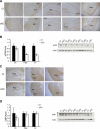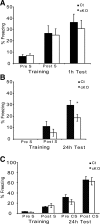Subregion-specific p300 conditional knock-out mice exhibit long-term memory impairments
- PMID: 21345974
- PMCID: PMC3056518
- DOI: 10.1101/lm.1939811
Subregion-specific p300 conditional knock-out mice exhibit long-term memory impairments
Abstract
Histone acetylation plays a critical role during long-term memory formation. Several studies have demonstrated that the histone acetyltransferase (HAT) CBP is required during long-term memory formation, but the involvement of other HAT proteins has not been extensively investigated. The HATs CBP and p300 have at least 400 described interacting proteins including transcription factors known to play a role in long-term memory formation. Thus, CBP and p300 constitute likely candidates for transcriptional coactivators in memory formation. In this study, we took a loss-of-function approach to evaluate the role of p300 in long-term memory formation. We used conditional knock-out mice in which the deletion of p300 is restricted to the postnatal phase and to subregions of the forebrain. We found that p300 is required for the formation of long-term recognition memory and long-term contextual fear memory in the CA1 area of the hippocampus and cortical areas.
Figures






References
-
- Alarcon JM, Malleret G, Touzani K, Vronskaya S, Ishii S, Kandel ER, Barco A 2004. Chromatin acetylation, memory, and LTP are impaired in CBP+/- mice: A model for the cognitive deficit in Rubinstein-Taybi syndrome and its amelioration. Neuron 42: 947–959 - PubMed
-
- Albasser MM, Davies M, Futter JE, Aggleton JP 2009. Magnitude of the object recognition deficit associated with perirhinal cortex damage in rats: Effects of varying the lesion extent and the duration of the sample period. Behav Neurosci 123: 115–124 - PubMed
-
- Allis CD, Berger SL, Cote J, Dent S, Jenuwien T, Kouzarides T, Pillus L, Reinberg D, Shi Y, Shiekhattar R, et al. 2007. New nomenclature for chromatin-modifying enzymes. Cell 131: 633–636 - PubMed
Publication types
MeSH terms
Substances
LinkOut - more resources
Full Text Sources
Miscellaneous
